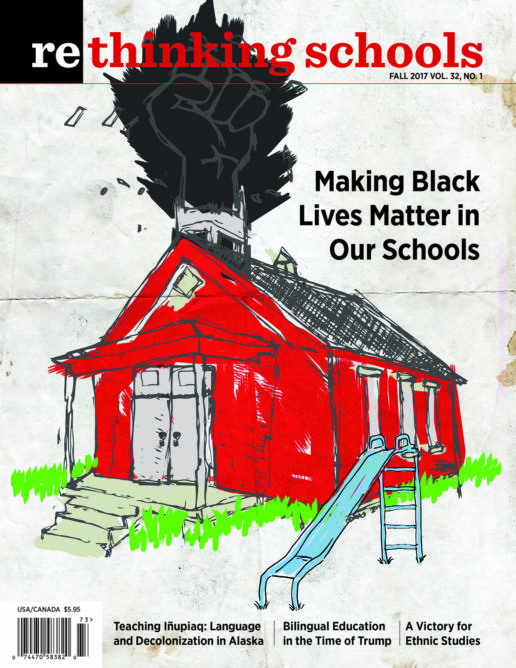Who Do I Belong To?
A Black Teacher's Dilemma
Illustrator: Rafael López

Rafael López
My 9th-grade global studies students were preparing arguments for a trial role-play for their semester final. After going over the day’s expectations, I released them into groups to finish writing. I stopped and checked in with each group while walking around the classroom to discuss the direction they were taking with their presentations. After conferencing with a few students, I walked over to Izabel, Jalen, Alex, and Camila’s table.
“How is it going?” I asked. “Real good, Ma’am,” Jalen replied while giving me his typical mischievous smile. Jalen, an African American student who recently transferred from another area high school, is technically a 10th grader but was placed in my class for credit recovery. Despite transferring during the last two weeks of the semester, Jalen has been fearless as he has settled into my class. While he refused to do any work, he was charming and personable, and was willing to raise his hand and answer a question within his first five minutes in my class.
“All right,” I responded. “Don’t forget: Your defenses need to be completed and typed for the role play by our next class.”
Remembering that I had brought in a snack for the students to munch on while writing, I placed a tub of cookies in the middle table of the room. “Class, I brought in the cookies you like as a treat.” I immediately stepped away because these students usually get very excited whenever I bring in snacks. Not disappointing, several students raced to the cookies.
Walking over to my computer, I heard Jalen shout, “Damn, nigger!” and I quickly looked up. Jalen looked upset and was glaring at Colin who was walking to his table with a fistful of cookies. I surveyed the room — Ellen, Jake, and Riley were opening their notebooks; Jace, whose face was bright red, was deliberately putting something in his bag; but pretty much the rest of the class was looking at me in disbelief. “Excuse me?” I asked the whole class, despite knowing exactly who had said it. “My bad,” Jalen responded. “Yes, that was your bad,” I replied, following up with “I do not want to hear that word used again.”
Head down, Jalen walked back to his table and glanced at me as he sat. At this point I was anxious. I felt strongly that my brief reprimand of Jalen was not enough for him and the other students in the classroom, but I realized that how I needed to deal with Jalen individually was in direct conflict with how I needed to address the class. As an African American teacher in an affluent, suburban, predominantly white school, I was torn. If I publicly continued to reprimand Jalen, I knew I would be fracturing the new teacher-student relationship we had established. If I used this as a teachable moment to lead a class discussion, I would be using Jalen’s words as the platform, which would hurt him, as it was evident that he was trying desperately to fit in. But I also wanted to give Jalen the opportunity to just be himself. As it is, African Americans are already required to assess and adjust in our daily lives. Everything we do is under intense scrutiny, and shouldn’t school be the one place Jalen doesn’t have to change the way he talks?
I looked over at Jalen, and while he was in discussion with his group, he periodically looked over to me, checking to see if I was looking at him, and if I was angry with him.
To add to this difficulty, I understood him. I knew why he had said it, how he was feeling, and what he meant. I am fully aware of the historical racist context behind the N-word but within the African American community and amongst my friends, this is a word we feel comfortable using with one another, but only with one another. Looking at Jalen I knew he did not understand this. To be one of a few is lonely. To be the “only” someone or something is frustrating. To be the only African American student in a class with a completely different socioeconomic makeup from where you came can be just too much. I was already worried about him. He was such a sweet kid, but I was not sure whether he understood the intricacies of navigating a privileged, predominantly white school and I was afraid he was getting lost in the process. He had recently transferred from Milwaukie High School, serving a largely working-class community in suburban Portland — these two schools couldn’t be more different. I had heard rumors of his behavior at his last school but as I stated to him after welcoming him on his first day, a new school meant a new opportunity to start on a clean slate.
Feeling the need to do or say something, I struggled with the questions: Who did I belong to at that moment? Who was I there for? Who should I support?
Publicly reprimanding Jalen and having a class discussion on the N-word could have led to an understanding that these 9th graders desperately needed. It could have been the opportunity to discuss the historical context and related contemporary issues. I also was concerned that the classroom culture that we had created had somehow been altered, but I also felt that at that moment, I belonged to Jalen. I needed to let him know that his use of the word was inappropriate and I was disappointed in him, while reassuring him that he and I were still good.
Looking over at Jalen one more time, he quickly turned away when I caught his eye. “Jalen, can we talk outside?”
“Laboss, I am sorry but there is nothing wrong with that word,” he said as soon as we were standing outside of the class.
“Jalen, I got you and totally understand, but you should not have said it.”
“Fine, I am sorry. I won’t say that word in your class anymore,” he said, looking down at the floor.
“This is bigger than my class. You can’t say that word anymore because you just let a whole bunch of white students feel comfortable hearing that word and that is not OK.”
I wanted him to realize the power he had in his words and actions.
“Man, everyone is always talking about how we should not say it, but there is nothing wrong with it, rappers say it all the time and have you seen that show The Boondocks? They say it all of the time. It is a term of affection.”
“Huh?” I looked at him with disbelief. His argument made it clear that while he understood the different ways the N-word could be used, he clearly did not get the code regarding where and with whom.
“Were you trying to be affectionate with Colin?” I asked.
“Nah, that nigger was grabbing all of the cookies.”
Feeling at this point that we were going in circles, I quickly nodded at my instructional aide to let her know this talk was going to be a bit longer and I asked Jalen to walk with me.
“Where we going?”
I reassured him that he was not in trouble and told him that I just wanted to walk around the school. I felt like I needed some reinforcement and hoped that we would run into Marcus. Marcus is the campus security supervisor at my high school and the only African American male staff member in a building of 2,500 students and about 300 teachers, administrators, and staff. His easy-going, no-nonsense attitude made him popular with our students. Not disappointing, we ran into Marcus while he was walking out of a classroom.
“Hi, what’s up?” I asked.
Marcus looked back and forth between the two of us and responded, “Nothing much,” while patting Jalen on the back.
As the three of us walked back toward my classroom, I realized that I needed to wrap this up as I had been away from my class for some time.
“Marcus, we just had an incident in the classroom where Jalen called someone the N-word.”
“You did what?” Marcus raised his voice while stepping closer to Jalen. “Nah, man, you can’t do that in this building.”
“You guys are tripping. I told Laboss ain’t nothing wrong with it,” said Jalen, who was becoming increasingly frustrated.
“Man look into the classroom,” Marcus said, while pulling him closer to the window that looks into my class. “How many Black people do you see?”
“None,” Jalen responded, looking down.
“Exactly,” said Marcus. Interrupting, I asked, “How would you feel if they called you that word?” and Marcus added, “How would you feel if they said that to me or Laboss?”
Jalen responded softly: “I would have to punch them in their face.”
“Exactly,” Marcus said.
“Like I said, Jalen, I get you but you can’t say that word around here because these other kids don’t understand that they do not have a right to say it, and when you say it in my room you are making it OK.”
Marcus added, “You are putting both of us in a really bad place and you can’t do that because we are here to look out for you.”
Feeling that we had made some gains with him, I jokingly told him to get back to class and get some cookies. Marcus and I silently shook our heads while giving each other looks of frustration, agreement, and satisfaction.
Teachers of color have difficult experiences working in predominantly white schools. On any given day, we may be forced to make decisions that question “who do we belong to” at that particular moment. We have to make these decisions because the needs of many may conflict with the needs of one. As an African American teacher I do not want my students of color to walk away feeling that my class was just another class that left them feeling invisible. It would be great to say that as teachers, we give all of our students 100 percent of ourselves every single day. But at times, my students of color need reassurance or direction on how to operate in a predominantly white building. I care for all of my students, but at times I just belong to one.
I did not have a classroom discussion about the use of the N-word.

